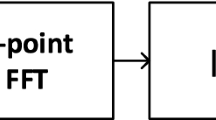Abstract
A reconfigurable and hardware proficient hybrid VLSI architecture is greatly necessitated for spectrum sensing that is a combination of energy detection and time domain cyclostationary techniques for cognitive radio applications. One among the key features of Cognitive Radio is Spectrum Sensing which is exploited for allocating unused frequency band efficiently. Various research works are being carried out to investigate the different spectrum sensing methods and analyze the advantages, disadvantage and applications. Here, the novel idea is to design a hybrid architecture by combining energy detection and time domain cyclostationary techniques by exploiting the advantages of those techniques and can be selected based on the applications. Also an energy efficient Low Latency Column Bit Compressed (LLCBC) MAC is greatly utilized in this hybrid architecture to design an Application Specific Integrated Circuit more efficiently. The Proposed method thus helps in achieving significant VLSI parameters such as area, power and delay when compared with the existing time domain cyclostationary technique. The proposed Cyclostationary-based Spectrum Sensing Architecture using LLCBC MAC also yields 4.3% Area reduction, 19.5% Power reduction and with no change in Delay when compared with existing Cyclostationary-based Spectrum Sensing Architecture. Also, in Hybrid Spectrum Sensing Architecture embedding LLCBC MAC unit, a significant reduction in Area and Power corresponding to 57%, and 32% are achieved respectively, besides Hybrid Architecture is 15.28% faster than the individual architectures.














Similar content being viewed by others
References
Haykin, S. (2005). Cognitive radio: brain-empowered wireless communications. IEEE Journal on Selected Areas in Communications , 23(2), 201–220
Murty, M. S., & Shreshtha, R. (2018). Hardware implementation and VLSI design of Spectrum sensor for next generation LTE-A cognitive-radio Wireless Network. IET Circuits, Devices & Systems. https://doi.org/10.1049/iet-cds.2017.0292
Sutton, P. D., Nolan, K. E., & Doyle, L. E. (2008). Cyclostationary signatures in practical cognitive radio applications. IEEE Journal on Selected Areas in Communications, 26(1), 13–24
Joshi, G. P., Nam, S. Y., & Kim, S. W. (2013). Cognitive radio wireless sensor networks: applications, challenges and research trends. Sensors, 13(9), 11196–11228
Khan, A. A., Rehmani, M. H., & Reisslein, M. (2016). Cognitive radio for smart grids: Survey of architectures, spectrum sensing mechanisms, and networking protocols. IEEE Communication Survey Tutorials, 18(1), 860–898
Yucek, T., & Arslan, H. (2009). A survey of spectrum sensing algorithms for cognitive radio applications. IEEE Communication Survey Tutorials, 11(1), 116–130
Manesh, M. R., Apu, S., Kaabouch, N., & Hu, W. (2016). Performance evaluation of spectrum sensing techniques for cognitive radio systems. ubiquitous computing. Electronics & Mobile Communication Conference (IEEE Annual), 19, 1–6
Banovic, K., & Carusone, T.C. (2017). A sub-mW spectrum sensing architecture for portable IEEE 802. 22 cognitive radio applications. 2017 IEEE International Symposium on Circuits and Systems (ISCAS). https://doi.org/10.1109/iscas.2017.8050567
Abhijeet, A., Chincholkar, Chaitali, & Thakare, H. (2014). Matlab Implementation of spectrum sensing methods in cognitive radio. Global Journal of Engineering Science and Research Management, 19–28
Kaur, R., & Sharma, S. (2017). Analysis of hybrid model based on energy and cyclostationary spectrum sensing techniques. International Journal of Scientific & Engineering Research, 8(2), 197–204
Kaur, R., & Sharma, S. (2016). A review on hybrid spectrum sensing based on energy and cyclostationary techniques. International Journal of Innovations in Engineering and Technology, 7(3), 307–310
Ishwerya, P., Geethu, S., & Lakshminarayanan, G. (2017). An efficient hybrid spectrum sensing architecture on FPGA. IEEE WiSPNET 2017 Conference. https://doi.org/10.1109/WiSPNET.2017.8299843
Zahmati, A. S., Fernando, X., & Grami, A. (2014). A hybrid spectrum sensing method for cognitive sensor networks. Wireless Personal Communications: An International Journal, 74, 953–968
Ivanov, A., Mihovska, A., Tonchev, K., & Poulkov, V. X. (2018). Real-time adaptive spectrum sensing for cyclostationary and energy detectors. IEEE Aerospace and Electronic Systems Magazine, 33(5–6), 20–33. https://doi.org/10.1109/maes.2018.170098
Negi, M., & Singh, S. (2016). Selective variant intelligent spectrum sensing for cognitive radio. International Journal of Advanced Research in Computer and Communication Engineering, 5(7), 152–157
Ghosh, S. K., Mehedi, J., & Samal, U. C. (2018). Sensing performance of energy detector in cognitive radio networks. International Journal of Information Technology. https://doi.org/10.1007/s41870-018-0236-7
Sharma, A., & Chauhan, A. (2016). Spectrum sensing based on multiple energy detector for cognitive radio systems under noise uncertainty. IEEE 1st International Conference on power Electronics, Intelligent Control and Energy Systems (ICPEICES). https://doi.org/10.1109/ICPEICES.2016.7853328
López-Benítez, M., & Casadevall, F. (2012). Improved energy detection spectrum sensing for cognitive radio. IET Communication, 6, 785–796
Xiang, L., Bin, W., Hong, W., Pin-Han, H., Zhiqiang, B., & Lili, P. (2012). Adaptive threshold control for energy detection based spectrum sensing in cognitive radios. IEEE Wireless Communication Letter, 1, 448–451
Suguna, R., & Vimalathithan, R. (2019). An SoC architecture for energy detection based spectrum sensing using low latency column bit compressed (LLCBC) MAC for cognitive radio wireless sensor networks. Microprocessor and Microsystems, Elsevier, 69(6), 159–167
Chaudhari, S., Kosunen, M., & Mäkinen, S. (2016). Performance evaluation of cyclostationary-based cooperative sensing using field measurements. IEEE Transaction Vehicles Technology, 65(4), 1982–1997
Ikuma, T., & Naraghi-Pour, M. (2010). Autocorrelation-based spectrum sensing for cognitive radios. IEEE Transaction Vehicles Technology. https://doi.org/10.1109/ICCCN.2008.ECP.102
Suguna, R., & Vimalathithan, R. (2020). High speed low latency column bit compressed (LLCBC-MAC) unit for wireless sensor network applications. Computer Communications Journal, Elsevier, 150(1), 739–746
Dandawate, A. V., & Giannakis, G. B. (1994). Statistical tests for presence of cyclostationarity. IEEE Transactions on Signal Processing, 42(9), 2355–2369
Lundn, J., Koivunen, V., Huttunen, A., et al. (2007). Spectrum sensing in cognitive radios based on multiple cyclic frequencies. International Conference on Cognitive Radio Oriented Wireless Networks and Communications (CROWNCOM). https://doi.org/10.1109/CROWNCOM.2007.4549769
Neyman, J., & Pearson, E. S. (1933). On the problem of the most efficient tests of statistical hypotheses. Philosophical Transactions of the Royal Society: Mathematical, Physical and Engineering Sciences, 231(694–706), 289–337
Author information
Authors and Affiliations
Corresponding author
Additional information
Publisher's Note
Springer Nature remains neutral with regard to jurisdictional claims in published maps and institutional affiliations.
Rights and permissions
About this article
Cite this article
Suguna, R., Rathinasabapathy, V. Hybrid spectrum sensing architecture using LLCBC MAC for CR-WSN applications. Analog Integr Circ Sig Process 108, 657–669 (2021). https://doi.org/10.1007/s10470-021-01848-5
Received:
Revised:
Accepted:
Published:
Issue Date:
DOI: https://doi.org/10.1007/s10470-021-01848-5




